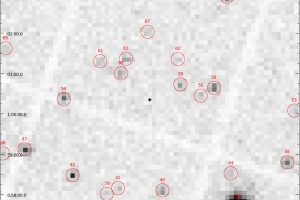Cepheids and X-ray emission. The study “X-rays in Cepheids: XMM-Newton Observations of η Aql” of N. R. Evans (SAO-CfA) recently appeared on AJ

Cepheids are stars of great importance, since they allow to determine the distance of galaxies within a few hundreds of million of light years from us. This is due to the pulsations that characterize these giant stars, which are going through an instable phase of their evolution. Because of these pulsations, the luminosity of these stars varies with a period which depends on their intrinsic luminosity (Leavitt law). By comparing the observed luminosity of the cepheids with the value inferred by the period of their pulsations, it is thus possible to derive their distances.
Observations in different bands of the electromagnetic spectrum are crucial to understand the complex phenomena responsible for the pulsations of the cepheids. Multi-band observations allow, in fact, to probe different layers of the atmosphere of these stars and their circumstellar environment. Besides, spectroscopic observations provide diagnostics that probe the phenomena occurring in the stellar photosphere and chromosphere, and whose intensity changes with the pulsation. For instance, the X-ray emission of the two cepheid stars δ Cep and β Dor is observed to vary significantly during the pulsation period, being fainter when the stellar radius is minimum, and brighter when the radius is maximum. These observations are of great importance, since they demonstrate that the outer layers of the atmosphere of the cepheids, where the X-ray emission is produces, is affected by the pulsations.
With the aim of understanding the relation between the X-ray emission and pulsation in the cepheids, the team of researchers led by the astronomer N. R. Evans (Smithsonian Astrophysical Observatory) analyzed X-ray observations of the cepheid star η Aql, in order to verify whether the star is a bright X-ray emitter and if its emission varies with its pulsation. However, the observations, obtained with the satellite XMM-Newton of the European Space Agency, do no reveal any detectable X-ray emission from η Aql. The different X-ray emission of η Aql and δ Cep is not a consequence of a different mass or age, since these stars have similar pulsation periods, suggesting that the two stars have similar stellar parameters. The authors of the study suggest that this can be due to differences in the magnetic field (which is poorly studied in the cepheids) or because the X-ray emission in η Aql is perturbed by its companions. This star has in fact a companion with spectral class B9.8V at about 1 Astronomical Unit (1 AU, which is the average distance between Earth and Sun, equal to 150 million of km) of separation, and a more distant companion (180 AU) of spectral class F. The study is described in the paper: “X-Rays in Cepheids: XMM-Newton Observations of η Aql“, recently appeared on The Astrophysical Journal, with the astronomer I. Pillitteri of INAF -Astronomical Observatory of Palermo being one of the coauthors.
The figure (click here to visualize the entire image) shows the XMM-Newton image analyzed in this study, with the position of η Aql marked with a cross and those of the detected X-ray sources with red circles.
Mario Giuseppe Guarcello ( follow mguarce) ( youtube)
Subscribe the Youtube channel of the Astronomical Observatory of Palermo
